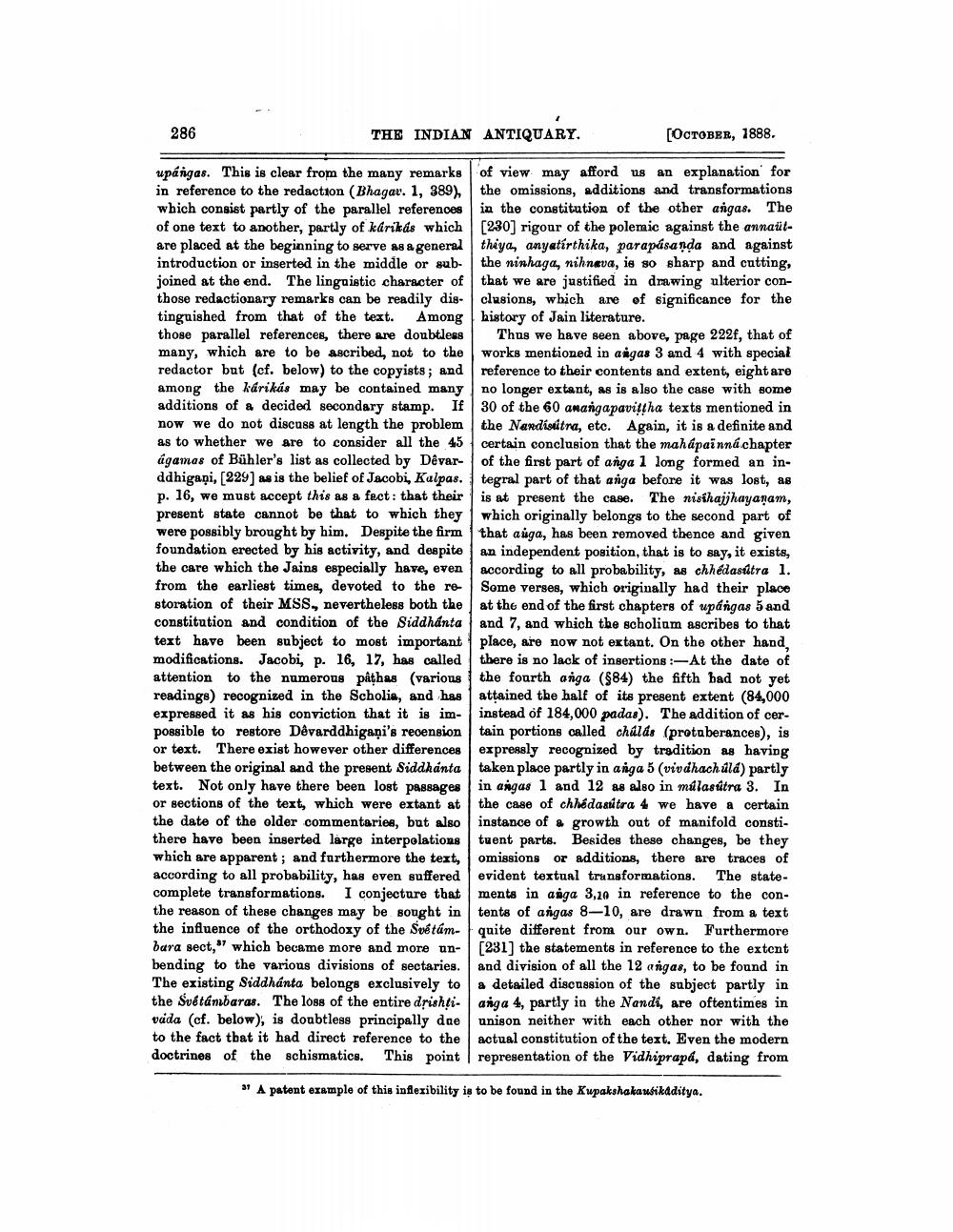________________
286
THE INDIAN ANTIQUARY.
[OCTOBER, 1888.
upangas. This is clear from the many remarks of view may afford us an explanation for in reference to the redaction (Bhagar. 1, 389), the omissions, additions and transformations which consist partly of the parallel references in the constitution of the other angas. The of one text to another, partly of karikás which [230] rigour of the polemic against the annaülare placed at the beginning to serve as a general theya, anyatírthika, parapásanda and against introduction or inserted in the middle or sub- the ninhaga, nihneva, is so sharp and cutting, joined at the end. The linguistic character of that we are justified in drawing ulterior conthose redactionary remarks can be readily disclusions, which are of significance for the tinguished from that of the text. Among history of Jain literature. those parallel references, there are doubtless Thus we have seen above, page 222f, that of many, which are to be ascribed, not to the works mentioned in angas 3 and 4 with special redactor but (cf. below) to the copyists; and reference to their contents and extent, eight are among the kárikás may be contained many no longer extant, as is also the case with some additions of a decided secondary stamp. If 30 of the 60 anangapavittha texts mentioned in now we do not discuss at length the problem the Nandisitra, etc. Again, it is a definite and as to whether we are to consider all the 45 certain conclusion that the mahāpainná chapter agamas of Bühler's list as collected by Dêvar of the first part of anga 1 long formed an inddhigaņi, (229) as is the belief of Jacobi, Kulpas. tegral part of that anga before it was lost, as p. 16, we must accept this as a fact: that their is at present the case. The nisihajjhayanam, present state cannot be that to which they which originally belongs to the second part of were possibly brought by him. Despite the firm that auga, has been removed thence and given foundation erected by his activity, and despite an independent position, that is to say, it exists, the care which the Jains especially have, even according to all probability, as chhedasútra 1. from the earliest times, devoted to the re- Some verses, which originally had their place storation of their MSS., nevertheless both the at the end of the first chapters of upangas 5 and constitution and condition of the Siddhanta and 7, and which the scholium ascribes to that text have been subject to most important place, are now not extant. On the other hand, modifications. Jacobi, p. 16, 17, has called there is no lack of insertions:-At the date of attention to the numerous pâthas (various the fourth anga (884) the fifth had not yet readings) recognized in the Scholia, and has attained the half of its present extent (84,000 expressed it as his conviction that it is im- instead of 184,000 padas). The addition of cerpossible to restore Dêvarddhigaņi's recension tain portions called childs (protuberances), is or text. There exist however other differences expressly recognized by tradition as having between the original and the present Siddhanta taken place partly in anga 5 (vivdhachuld) partly text. Not only have there been lost passages in angas 1 and 12 as also in malasútra 3. In or sections of the texty which were extant at the case of chheda sutra 4 we have a certain the date of the older commentaries, but also instance of a growth out of manifold constithere have been inserted large interpolations tuent parts. Besides these changes, be they which are apparent; and furthermore the text, omissions or additions, there are traces of according to all probability, has even suffered evident textual transformations. The statecomplete transformations. I conjecture that ments in anga 3,20 in reference to the conthe reason of these changes may be sought in tents of angas 8-10, are drawn from a text the influence of the orthodoxy of the Svétám- quite different from our own. Furthermore bara sect," which became more and more on- [231] the statements in reference to the extent bending to the various divisions of sectaries. and division of all the 12 angas, to be found in The existing Siddhanta belongs exclusively to a detailed discussion of the subject partly in the Svetambaras. The loss of the entire drishti- anga 4, partly in the Nandi, are oftentimes in vada (cf. below), is doubtless principally dae unison neither with each other nor with the to the fact that it had direct reference to the actual constitution of the text. Even the modern doctrines of the schismatics. This point representation of the Vidhiprapá, dating from
31 A patent example of this inflexibility is to be found in the Kupakshakausikaditya.




